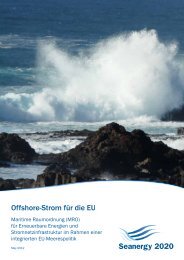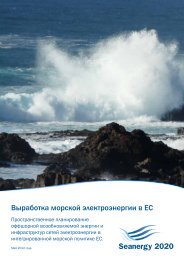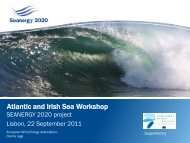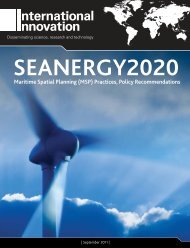Comparative analysis of Maritime Spatial Planning ... - Seanergy 2020
Comparative analysis of Maritime Spatial Planning ... - Seanergy 2020
Comparative analysis of Maritime Spatial Planning ... - Seanergy 2020
You also want an ePaper? Increase the reach of your titles
YUMPU automatically turns print PDFs into web optimized ePapers that Google loves.
equires a high number <strong>of</strong> licenses but clear and coordinated procedures provided a one-stop shop for theprocess as a whole. For the project proposer there are clear advantages in the simplification <strong>of</strong> a one-stopshop.In terms <strong>of</strong> maritime basins the countries <strong>of</strong> the North Sea, where most <strong>of</strong> the existing <strong>of</strong>fshore installedcapacity is currently located, generally have well developed permitting systems. Perhaps a little surprisinglythe Atlantic coasts, given the wind climate, seem poorly served at the moment with respect to planning forO-RE although France has recently taken important steps. The poor development <strong>of</strong> the Mediterranean Seabasin may partly reflect relatively fewer opportunities with existing technologies given the nature <strong>of</strong> thedeep basins but also the rather anomalous legal position given the lack <strong>of</strong> EEZs. This, in itself, leads tomore potential conflict with other users such as fisheries as discussed above.Germany is a rather unusual case with the responsibilities split in the maritime zones between Federal andRegional authorities. In addition, or possibly because <strong>of</strong> this, the WindBarriers project shows that Germanyneeds a rather longer than average time to complete the whole process. Nevertheless the permittingprocess in Germany definitely accelerated with the introduction <strong>of</strong> MSP in 2009 showing the synergy therecan be between MSP and the Offshore Renewable sector.It may also be significant that in terms <strong>of</strong> installed capacity the leading countries generally have the mosttransparent and coordinated systems. This is possibly due to learning from experience and the pressure foreconomic development <strong>of</strong> the sector. This in turn is generated by political will and a determined planningpolicy which remains the greatest driver.Clearly there are cases where MSP is synergistic with O-RE development but probably the policycommitment is the greater element. For example, the key to the British system, which has overseen thegreatest installed capacity <strong>of</strong> any Member State, is a mixture <strong>of</strong> pragmatism, as has been discussed, andalso a perception that the planning agencies themselves are favourably disposed towards <strong>of</strong>fshore windfarm proposals again emphasising the importance <strong>of</strong> commitment. The UK does not favour a binding MSPapproach but nevertheless does have a „criteria based‟ planning system suggesting that maritime planningas such, remains important.Ultimately, best practice in the permitting process should include a legal framework for issuing licencesand permits which is clear and efficient, but most importantly the institutional set-up, includingjurisdictions and cooperation/coordination mechanisms should be designed in a way to allow for a finaldecision covering all aspects <strong>of</strong> a permit in a comprehensive, coherent, consistent and cost/effectivemanner.4.2 RecommendationsBased on the previous <strong>analysis</strong> the following policy recommendations emerge:Permitting should be conditional on a full and satisfactory environmental appraisal or EIA;Deliverable 2.327 | P a g e






